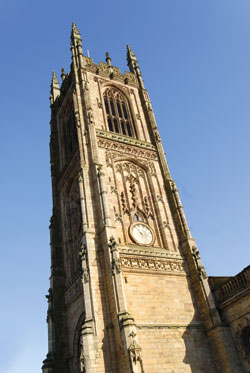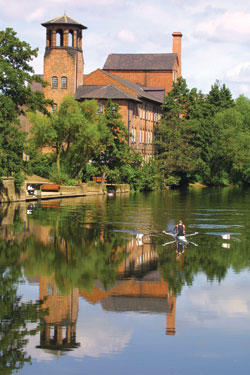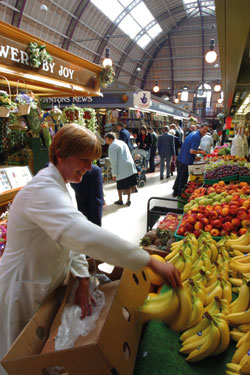If there is any English city that belies its charming but modest appearance, it’s Derby, on the banks of the River Derwent, south of the soaring Peak District. Plan a short break in the city that not only celebrates its industrial heritage but also its exciting present.
Pat Moore tells us how best to plan a short break in the city that not only celebrates its industrial heritage but also its exciting present.
 |
| Climb the Cathedral tower |
If there is any English city that belies its charming but modest appearance, it’s Derby, on the banks of the River Derwent, south of the soaring Peak District.
First settled by the Romans in AD43 and then the Danes in AD875, Derby – from deor or deer encampment – has always gone quietly about its business. That pretty 19th-century Market Place, those winding streets, quaint alleyways and leafy suburban terraces hide a fact unknown to many visitors. For centuries, but especially the last 400 years, it’s been a centre for some of the greatest talent in textiles, the arts, engineering and invention this country has produced.
Throughout The Enlightenment, the 18th-century intellectual movement, Derby was at the forefront of scientific and technical expertise with luminaries like William Wilberforce and Erasmus Darwin sharing ideas with Benjamin Franklin and Thomas Jefferson.
This was when the Loombe Brothers opened Derby Silk Mill “the world’s first modern factory,” with its silk throwing machine, the design pirated from Italy, in 1717. It could make 318,504,960 yards of twisted silk thread in “One Day and One Night” using Italian and Chinese raw silk, and was a major employer. A special bell summoned workers each morning and small children were employed to fix tags on silk shoelaces. Burned down in 1910 and rebuilt, it’s now Derby Industrial Museum, part of the 15-mile Derwent Valley Mills World Heritage Site that stretches from Matlock Bath to Derby. A walk along the riverbank takes visitors past examples of industrial architecture where everything from Jedediah Strutt’s ribbed stockings to bridges were once produced.
 |
| Derby’s Silk Industrial Mill |
Along here, too, was Derby’s Porcelain factory, opened in 1750 by potter William Duesbury. King George III allowed the Crown to be used as a back stamp in 1773 and after, Queen Victoria’s visit in 1890, it became Royal Crown Derby. Today in Osmaston Road, a short distance from the city centre, it is the only factory in the country producing fine English porcelain. Tours take you through the whole fascinating process from the first mould, through firing and decoration to products in the shop. You won’t be able to resist a purchase.
Trains played a big part in Derby’s history from the mid-19th century when the Midland Railway Company made engines and built the red brick Midland Hotel by the station. Beautifully restored, it’s charmingly Victorian.
Just along the road is a row of 19th-century railwaymen’s cottages, with tiny flower-filled gardens and The Britannia, which is also one of Derby’s two micro-breweries that sell real ales.
Rolls Royce opened a factory in Derby making their beautiful cars in 1907, switching to Spitfire engines during World War II. An aero-engine and railway memorabilia – including a signal box and model track – can now be found in the Industrial Museum housed in the former Silk Mill.
An equestrian statue of a less fortunate Derby visitor stands on the newly-created Cathedral Green. Bonnie Prince Charlie and his army, hoping to restore a Stuart to the throne and depose Hanoverian George II, entered the town in 1745 en route for London. Met by the force of the Duke of Devonshire and with no support from the townspeople, after only one night he retreated to Scotland and defeat at the Battle of Culloden. His panelled lodgings, complete with stormy sound effects, has been recreated at the Derby Museum and Art Gallery on The Strand, “This cold winter has seen our venture’s downfall”, he writes sadly.
 |
| Shopping in the Victorian market hall |
Cathedral Green is just one of Derby’s exciting regeneration schemes. Over £2billion is being invested in everything from hotels – like the Cathedral Quarter Hotel – parks and a casino, to a new bridge across the River Derwent. Already in place is Westfield, a gigantic glass shopping “palace”, which incorporates the 1970s Eagle Centre and not only contains all the top high street names and boutiques but also the 12-screen Cinema de Lux.
Close by in Market Place is the recently opened QUAD, an £11million glass art and film centre which aims “to show the best in independent cinema” and help to promote local artists’ work. Complete with cafe and comfy seats, it’s the ideal spot to catch an art house or foreign film after dinner.
After two interesting days in Derby, I’m not surprised that its emblem is the ram – there’s a huge stone one on Exchange Street. Justifiably proud of its heritage, the city’s still determinedly forging ahead as it has for centuries.
Details
Tourist Information, Assembly Rooms, Market Place, Derby DE1 3AH; tel: (01332) 255802 or visit www.visitderby.co.uk.
How to get to Derby
- By train: East Midlands Trains run between London St Pancras and Yorkshire via Derby. For timetable and enquiries, contact National Rail Enquiries, tel: 0845 748 4950; www.nationalrail.co.uk.
- By coach: National Express, from various UK locations; tel: 0870 580 8080; www.nationalexpress.com.
- By air: The Derby Airline Shuttle links East Midlands Airport to the city centre. Visit www.kinchbus.co.uk for details.
Where to shop
Westfield Derby has to be top of the list because there is so much choice – the collection of clothes shops is is amazing. Children will love the Build-a-Bear shop where you can make up your teddy on the spot.
I also enjoyed wandering round the Victorian Market Hall where stalls sell everything from beef to buttons. Upstairs on Tuesday and Thursday (9am-2pm) there are five bric-a-brac and china seconds stalls to browse through.
If you need picnic food, head for the farmers’ market every third Thursday from 8am-2pm. Here are Derbyshire cheeses and succulent pork pies. Bakewell tarts and other delicacies are sold in Bird’s famous bakery on Iron Gate.
For fashion accessories, stroll down pretty Sadler Gate where two Canopy boutiques sell fabulous leather handbags and men’s brogues. I also liked Kyte for gifts and Classic Fine Arts for local artists’ work. Small shops are rapidly opening up in this quarter so it’s worth exploring the tiny alleyways and side streets.
Where to visit
My own favourite Derby delights begin with the mainly 18th-century Cathedral, which has the second tallest tower in England. It contains the tomb of one of my heroines: Bess of Hardwick, the much-married rival to Queen Elizabeth I. Nearby, at the entrance to St Katherine’s Chapel is Georgiana, Duchess of Devonshire’s coffin plate. She is buried in the Cavendish family vault below which is visited by the current Duke.
Here, too, is Joseph Wright of Derby’s tombstone. A master of light, his most famous painting A Philosopher Lecturing on the Orrery – and the orrery itself – is in the Derby Art Gallery and Museum. Originally built by a Victorian MP to show off a Bronze Age log boat – still on show – the museum has local history and Derby porcelain rooms, plus the finest public collection of Wright’s works in Britain. There’s also a fascinating exhibition showing all those great men that were his friends. A pillar at 34 Iron Gate marks his birthplace.
From here it’s a ten-minute stroll via The Strand and Sadler Gate – peek in 17th-century The Bell, Derby’s last surviving coaching inn – to The Silk Mill Industrial Museum. I loved the silk display including still fashionable russet stockings with clocks and cuban-heeled shoes. Be warned, the silk merchant’s head does move as he speaks. Don’t miss 15th-century St Mary’s, one of the only six bridge chapels in Britain.
Where to eat in Derby
Ye Olde Dolphin is Derby’s oldest pub, first licensed in 1530. The timber frame is 17th-century and the interior has ancient oak pews and wobbly floors. An atmospheric spot for a lunchtime snack. Nearby is the Cathedral Cafe, where the toasted teacakes are to die for. On the menu, too are delicious soups, Cathedral quiche, afternoon tea with scones, jam, cream and fruitcake.
The first evening I dined in the Cathedral Quarter Hotel’s Opulence restaurant. Light and airy, I enjoyed best end of lamb with confit shoulder, pea puree, thyme fondant and a black pudding faggot. For dessert, Tom, the friendly head waiter, advised the apple and cardomom Tarte Tatin with vanilla ice-cream and caramel sauce. Sublime.
The next evening I was recommended Masa. Situated in a Grade II-converted
Wesleyan chapel on Brook Street, the restaurant specialises in fish. I chose panfried halibut with lobster emulsion followed by a fabulously rich chocolate mousse.
Where to stay in Derby
Opened last April, the Cathedral Quarter Hotel (4-star) in St Mary’s Gate is Derby’s first boutique hotel, owned by the Finesse group. Built in 1893 and intended as a police station, it eventually became a police museum and its spa is appropriately called Clink.
I could see the Cathedral over the red rooftops from my large, comfortable room, decorated in subtle shades of creams and gold. Ultra-modern in amenities, the 38-luxury room hotel has cleverly retained its period features. There are comfy sofas, original marble floors and spectacular plaster ceilings, especially in the Opulence Restaurant where the delicious Derbyshire Full English Breakfast served by friendly staff has eight ingredients.
If you prefer a more homely bed and breakfast, try two Victorian guest houses: Red Setters (3-star) on Curzon Street or Rose and Thistle (3-star) on Charnwood Street. Well-situated for sightseeing, both specialise in good English breakfasts.
For self-catering there’s SACO Derby (4-star) apartments, or The Railway Cottage (3-star) at Midland Place.






 © 2024
© 2024